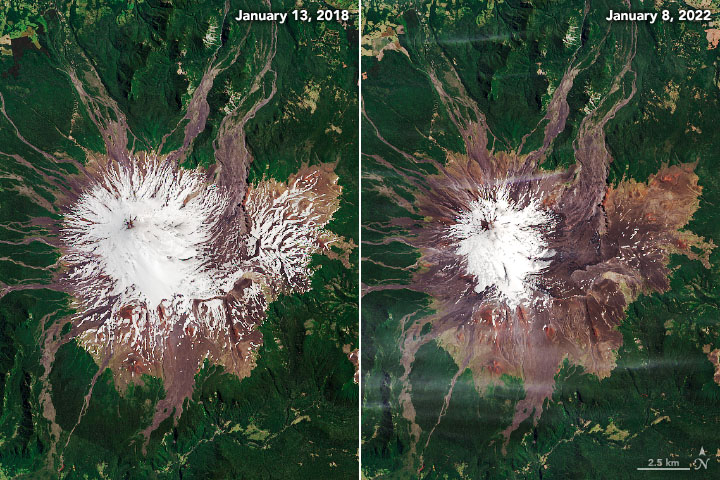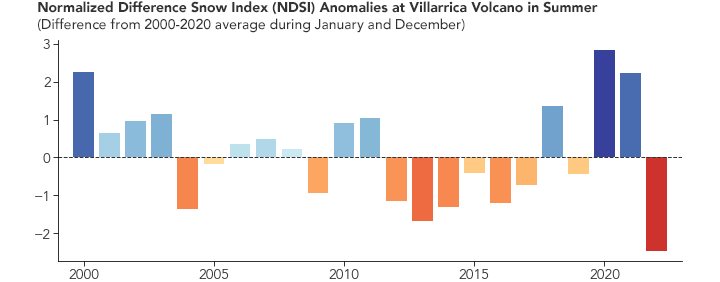


Pucón, Chile, is a popular summertime destination tucked between a glacier-carved lake and snow-capped volcano. Visible from nearly anywhere in the town, the stark-white slopes of Villarrica volcano form a majestic backdrop. But in summer 2022, the backdrop lacked its typical luster as the volcano’s slopes appeared more bare than usual.
According to René Garreaud, a scientist at the University of Chile, the meager snow cover in summer 2022 can be attributed to the lack of storms in 2021. “Last year was extremely dry along most of Chile, all the way from central Chile to Patagonia,” he said. It fits with a long-term trend of drought in the region.
The reduced snow cover is apparent in these images, acquired with the Operational Land Imager (OLI) on Landsat 8 during the southern hemisphere’s summer. Notice that the extent of snow and ice in January 2022 appears much smaller compared to January 2018, which followed a year with more typical amounts of snowfall.

The snow drought is also evident in this chart. Normalized Difference Snow Index (NDSI) observations from NASA’s Terra satellite indicate that the mean snow cover at Villarrica between December 2021 and January 2022 was substantially less than the 2000-2020 average for the same months. Note that the chart is showing snow cover area, not snow depth or snowfall amounts.
Villarrica is part of a chain of volcanoes that characterize the southern Andes Mountains in Chile’s Araucanía and Los Ríos regions. Areas to the north, in central Chile (including Santiago, 675 kilometers away) are quite a bit drier; areas to the south, in the Patagonia region, are more humid. The area around the volcanoes usually receives from 100 to 200 centimeters (39 to 79 inches) of precipitation per year, most of which falls in winter. But 2021 was exceptionally dry.
“Many stations near Villarica and to the south recorded their lowest accumulations since 1960,” Garreaud said, referring to the precipitation measured by the Chilean Weather Service between January 1 and December 31, 2021. Warm temperatures in spring and summer can enhance melting, but Garreaud thinks the dry conditions were the main reason for the reduced snow cover.
Other volcanos in the area are also low on snow this summer, including Mocho-Choshuenco located 55 kilometers (34 miles) south-southwest of Villarrica. Scientists recently used Landsat images to study snow cover trends on this volcano and found that snow that once persisted year-round at middle elevations is now seasonal.
The dry weather in 2021 is part of a continuing megadrought that has persisted in central Chile for more than a decade. Still, the dryness was not enough to deter Garreaud from vacationing near Villarrica this summer. He noted that while the area is drier than previous years, the landscape is “still much greener than Santiago.”
NASA Earth Observatory images by Joshua Stevens, using Landsat data from the U.S. Geological Survey and data from the Level-1 and Atmosphere Archive & Distribution System (LAADS) and Land Atmosphere Near real-time Capability for EOS (LANCE). Story by Kathryn Hansen.